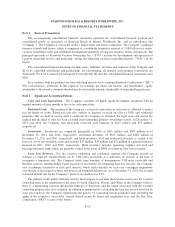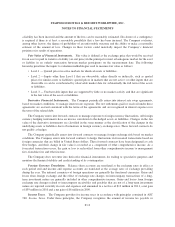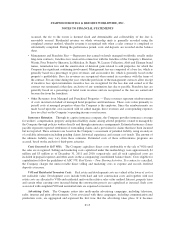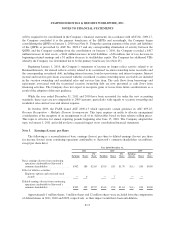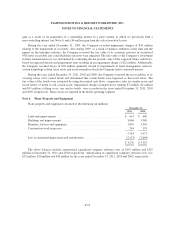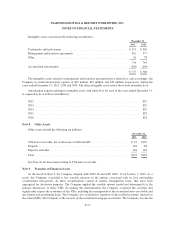Starwood 2011 Annual Report Download - page 130
Download and view the complete annual report
Please find page 130 of the 2011 Starwood annual report below. You can navigate through the pages in the report by either clicking on the pages listed below, or by using the keyword search tool below to find specific information within the annual report.STARWOOD HOTELS & RESORTS WORLDWIDE, INC.
NOTES TO FINANCIAL STATEMENTS
a liability has been incurred and the amount of the loss can be reasonably estimated. Disclosure of a contingency
is required if there is at least a reasonable possibility that a loss has been incurred. The Company evaluates,
among other factors, the degree of probability of an unfavorable outcome and the ability to make a reasonable
estimate of the amount of loss. Changes in these factors could materially impact the Company’s financial
position or its results of operations.
Fair Value of Financial Instruments. Fair value is defined as the exchange price that would be received
for an asset or paid to transfer a liability (an exit price) in the principal or most advantageous market for the asset
or liability in an orderly transaction between market participants on the measurement date. The following
hierarchy prioritizes the inputs to valuation methodologies used to measure fair value as follows;
• Level 1 — Quoted prices in active markets for identical assets or liabilities.
• Level 2 — Inputs other than Level 1 that are observable, either directly or indirectly, such as quoted
prices for similar assets or liabilities; quoted prices in markets that are not active; or other inputs that are
observable or can be corroborated by observable market data for substantially the full term of the assets
or liabilities.
• Level 3 — Unobservable inputs that are supported by little or no market activity and that are significant
to the fair value of the assets or liabilities.
Derivative Financial Instruments.The Company periodically enters into interest rate swap agreements,
based on market conditions, to manage interest rate exposure. The net settlements paid or received under these
agreements are accrued consistent with the terms of the agreements and are recognized in interest expense over
the term of the related debt.
The Company enters into forward contracts to manage exposure to foreign currency fluctuations. All foreign
currency hedging instruments have an inverse correlation to the hedged assets or liabilities. Changes in the fair
value of the derivative instruments are classified in the same manner as the classification of the changes in the
underlying assets or liabilities due to fluctuations in foreign currency exchange rates. These forward contracts do
not qualify as hedges.
The Company periodically enters into forward contracts to manage foreign exchange risk based on market
conditions. The Company enters into forward contracts to hedge fluctuations in forecasted transactions based on
foreign currencies that are billed in United States dollars. These forward contracts have been designated as cash
flow hedges, and their change in fair value is recorded as a component of other comprehensive income. As a
forecasted transaction occurs, the gain or loss is reclassified from other comprehensive income to management
fees, franchise fees and other income.
The Company does not enter into derivative financial instruments for trading or speculative purposes and
monitors the financial stability and credit standing of its counterparties.
Foreign Currency Translation. Balance sheet accounts are translated at the exchange rates in effect at
each period end and income and expense accounts are translated at the average rates of exchange prevailing
during the year. The national currencies of foreign operations are generally the functional currencies. Gains and
losses from foreign exchange and the effect of exchange rate changes on intercompany transactions of a long-
term investment nature are generally included in other comprehensive income. Gains and losses from foreign
exchange rate changes related to intercompany receivables and payables that are not of a long-term investment
nature are reported currently in costs and expenses and amounted to a net loss of $12 million in 2011, a net gain
of $39 million in 2010 and a net gain of $6 million in 2009.
Income Taxes. The Company provides for income taxes in accordance with principles contained in ASC
740, Income Taxes. Under these principles, the Company recognizes the amount of income tax payable or
F-13









